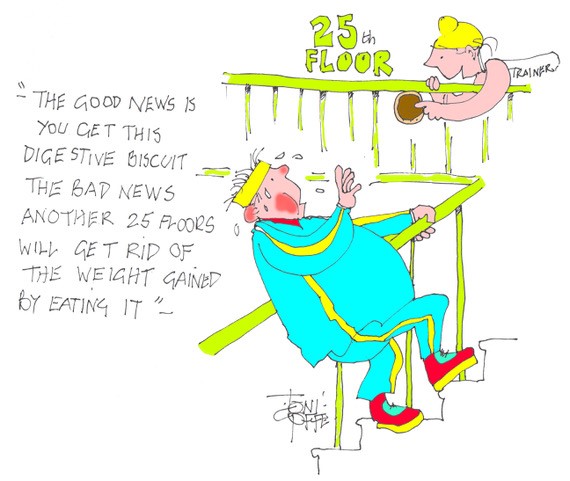Treating dyslipidaemia
The medical ill effects of dyslipidaemia
The main ill effect of dyslipidaemia is the promotion of atheroma – so-called hardening of the arteries. A high total cholesterol, a high ratio of total cholesterol to HDL cholesterol and raised triglyceride levels are all powerful risk factors for heart attacks, strokes and peripheral vascular disease. The total cholesterol/HDL-C ratio is an important element of the Q-Risk assessment for predicting cardiovascular diseases (CVD). Dyslipidaemia is also a feature of the ‘metabolic syndrome’ which I will talk about in a few weeks time. It is a combination of obesity, hypertension, diabetes and lipid abnormalities. The metabolic syndrome carries a particularly high risk of CVD, especially heart disease.
Diet or drugs?
The treatment of dyslipidaemia should involve changes in diet, but in practice most people find it nearly impossible to change the way they eat and maintain it. The modern treatment is the group of drugs known as the statins which are very effective. Not only do they reduce LDL-C by up to 30 per cent and also reduce the LDL/HDL ratio, but they reduce the risk of atheroma substantially – so substantially that it is regarded as obligatory to prescribe them for all those deemed to be at high risk and particularly for those who already have evidence of arterial disease.
Effect of exercise on lipids
The effect which exercise has on the different fat fractions found in the blood is not straightforward. There are age-related changes in total cholesterol and LDL cholesterol, both of which increase gradually with time. A study of physical fitness in 11,400 people who had several treadmill tests over 36 years found those in the lower third for fitness developed abnormal lipids 10–15 years earlier that those in the fittest third. In other words, it does seem that regular exercise delays the age-related development of undesirable changes in blood fats. This idea is supported by the finding that regular walking reduces both total cholesterol and the ratio of total cholesterol to HDL-C.
The data on the response of lipid abnormalities to exercise alone are surprisingly and disappointingly sparse, and sometimes contradictory. Regular exercise does seem to increase the levels of the protective HDL-C but the effect on other lipid fractions is less certain. The combination of diet with exercise, particularly if accompanied by weight loss does help to correct abnormal blood lipids. And exercise on its own also reduces the all-important total cholesterol/HDL-C ratio.
Triglycerides levels are acutely reduced by exercise for up to 24 hours. Physical training can increase this effect because fitter people can take more prolonged and more vigorous exercise.
Combined treatment
The most effective management of dyslipidaemia is the combination of statins, diet and exercise. In a cohort of 10,043 Americans with dyslipidaemia, among men treated with statins the risk of dying over the next 10 years for the most fit was just 30 per cent of the risk for the least fit.
To be really effective the exercise dose needs to be quite high. The American Heart Association and the American College of Cardiology, after a thorough appraisal of all the evidence, concluded that it may require 12 MET task hours per week of exercise to lower LDL-C. That is about 1 hour 40 minutes per week of very brisk walking (4mph).
Enjoy your walk – and don’t stroll.
 Remember – you can order a copy of my latest book here! This is directly through me for £12.50 and includes P&P.
Remember – you can order a copy of my latest book here! This is directly through me for £12.50 and includes P&P.
Alternatively, you can get in from Amazon for £14.99. The ebook version costs £4.49 but is free to Prime members!
From Alton Waterstones for £14.99
From Alton Cardiac Rehab for £12.00 which includes a donation to the Charity 💕
Subscribe to the blog
Categories
- Accelerometer
- Alzheimer's disease
- Blood pressure
- BMI
- Cancer
- Complications
- Coronary disease
- Cycling
- Dementia
- Diabetes
- Events
- Evidence
- Exercise promotion
- Frailty
- Healthspan
- Hearty News
- Hypertension
- Ill effects
- Infections
- Lifespan
- Lipids
- Lung disease
- Mental health
- Mental health
- Muscles
- Obesity
- Osteoporosis
- Oxygen uptake
- Parkinson's Disease
- Physical activity
- Physical fitness
- Pregnancy
- Running
- Sedentary behaviour
- Strength training
- Stroke
- Uncategorized
- Walking



I feel elated at having been back in the gym for a full week, having clocked up 150 mins plus 30 mins each day of home exercises. My gym speeds (treadmill and bike) are pathetic but I can feel that the treadmill walking has reminded my
body of some semblance of what an upright posture may at one time have looked like for me. The Healthier Together programme at Britannia (GLL) with an instructor prescribed by my GP is free for the first three months, an added bonus.